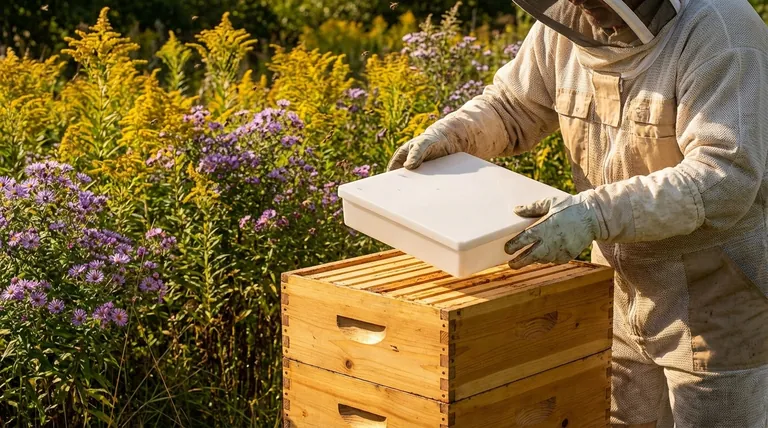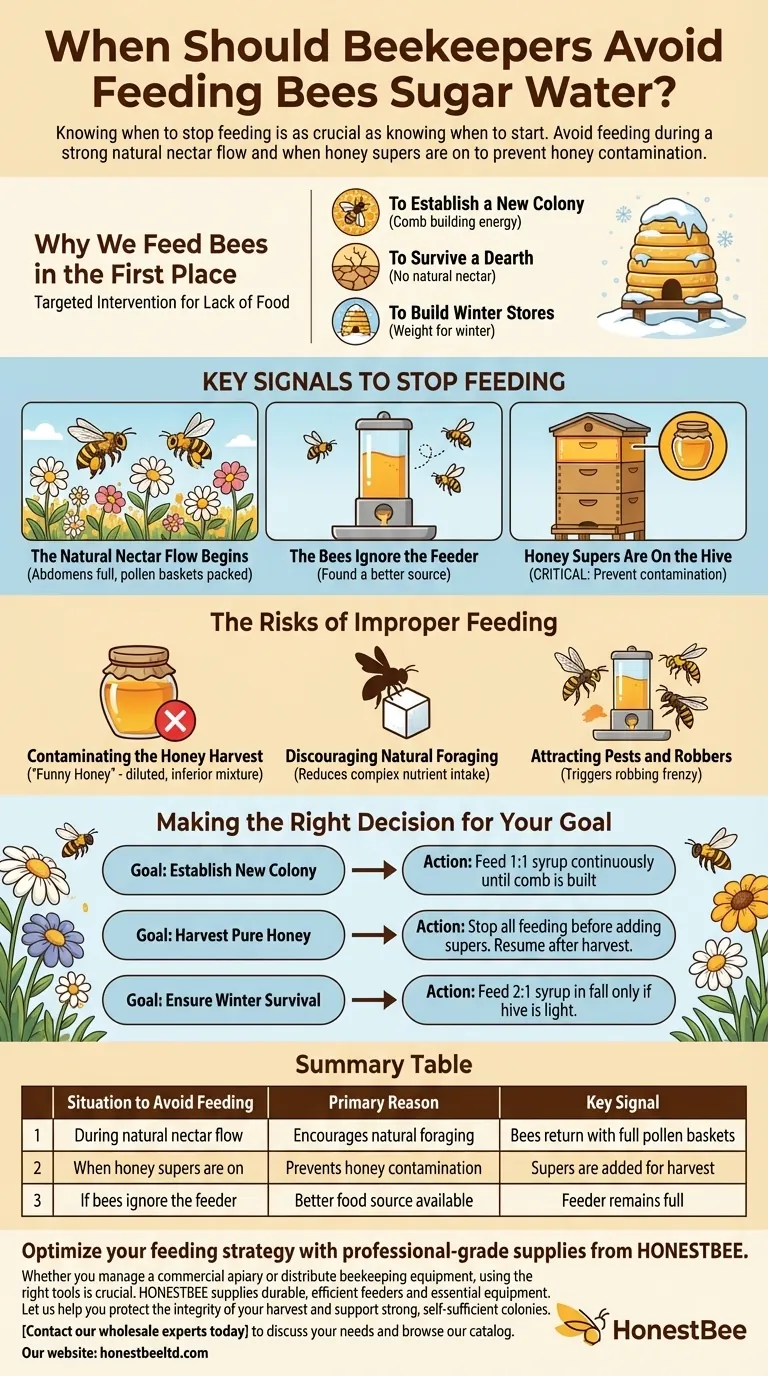Knowing when to stop feeding is as crucial as knowing when to start. You should avoid feeding bees sugar water in two primary situations: when a strong natural nectar flow is underway, and anytime you have honey supers on the hive that you intend to harvest for human consumption. Feeding during these periods can discourage natural foraging and, more importantly, will contaminate your honey harvest with sugar syrup.
Supplemental feeding is a specific tool to ensure a colony's survival, not a replacement for its natural function. The beekeeper's goal is to intervene only when necessary and step back when the bees can provide for themselves, protecting the integrity of both the colony and its honey.

Why We Feed Bees in the First Place
Understanding when not to feed begins with understanding why we do it. Feeding is a targeted intervention to solve a specific problem—a lack of food.
To Establish a New Colony
A new package of bees or a small nucleus hive has a monumental task: building wax comb. They need a massive amount of carbohydrate energy to power their wax glands, and sugar syrup provides a readily available fuel source to get them established quickly.
To Survive a Dearth
A "dearth" is a period when no nectar-producing flowers are in bloom. This often occurs in the heat of mid-summer or in the fall after the last major blooms have faded. Feeding during a dearth can be critical for preventing a colony from starving.
To Build Winter Stores
If a hive is light on honey stores heading into autumn, feeding a heavy 2:1 sugar syrup (two parts sugar to one part water) helps them pack away the necessary weight to survive the long, cold winter months.
Key Signals to Stop Feeding
Your bees and the environment will give you clear signs that it’s time to remove the feeder. Paying attention to these signals is fundamental to good hive management.
The Natural Nectar Flow Begins
When you see bees returning to the hive with abdomens full of nectar and pollen baskets packed, the nectar flow has started. The colony's activity will increase dramatically, and they will naturally prefer the nutritional diversity of real nectar over simple sugar water.
The Bees Ignore the Feeder
The most direct signal comes from the bees themselves. If you check your feeder and it remains full day after day, the bees are telling you they have found a better, more preferable food source elsewhere. It is time to remove the feeder.
Honey Supers Are On the Hive
This is the most critical rule. If you have added supers (the boxes used for honey collection), all feeding must stop immediately. Your goal is to harvest pure honey, not sugar syrup stored by bees.
The Risks of Improper Feeding
Feeding at the wrong time isn't just unnecessary; it can create significant problems for your hive and your honey harvest.
Contaminating the Honey Harvest
Bees do not differentiate between natural nectar and sugar syrup. They will process and store both in the honeycomb. If you feed while honey supers are on, you will end up harvesting a product known as "funny honey"—a diluted, inferior mixture that is not legally or ethically considered real honey.
Discouraging Natural Foraging
Providing an endless, easy source of sugar can sometimes reduce a colony's drive to forage. Natural nectar and pollen contain complex micronutrients, proteins, and minerals essential for bee health that are absent in plain sugar water.
Attracting Pests and Robbers
An active feeder, especially if it's leaky or not designed well, can attract ants, wasps, and—most dangerously—bees from other colonies. This can trigger a "robbing" frenzy where a stronger colony attacks a weaker one to steal its resources, often destroying the weaker hive in the process.
Making the Right Decision for Your Goal
Your feeding strategy should adapt to your specific goal for the hive at that moment.
- If your primary focus is establishing a new colony: Feed a 1:1 syrup continuously until the bees have built out all the comb in their first brood box.
- If your primary focus is harvesting pure honey: Stop all feeding before you add honey supers and do not resume until after you've harvested them for the year.
- If your primary focus is ensuring winter survival: Feed a heavy 2:1 syrup in the fall only if the hive feels light and lacks sufficient natural stores for winter.
Ultimately, let the bees and the seasons, not the calendar, guide your decision to feed.
Summary Table:
| Situation to Avoid Feeding | Primary Reason | Key Signal |
|---|---|---|
| During a natural nectar flow | Encourages natural foraging over dependency | Bees return with full pollen baskets |
| When honey supers are on | Prevents honey contamination with syrup | Supers are added for harvest |
| If bees ignore the feeder | Indicates a better food source is available | Feeder remains full for days |
Optimize your feeding strategy with professional-grade supplies from HONESTBEE.
Whether you manage a commercial apiary or distribute beekeeping equipment, using the right tools is crucial for hive health and honey purity. HONESTBEE supplies durable, efficient feeders and other essential equipment designed for serious beekeepers.
Let us help you protect the integrity of your harvest and support strong, self-sufficient colonies.
Contact our wholesale experts today to discuss your apiary's needs and browse our full catalog of reliable beekeeping supplies.
Visual Guide

Related Products
- HONESTBEE Professional Hive Top Bee Feeder Feeding Solution
- HONESTBEE Round Hive Top Bee Feeder for Syrup
- HONESTBEE Entrance Bee Feeder Professional Hive Nutrition Solution for Beekeeping
- Professional Hive Front Entrance Bee Feeder
- Classic Boardman Entrance Bee Feeder Hive Front Feeding Solution
People Also Ask
- What should be done with feeders and equipment after feeding bees? Essential Steps for Apiary Health
- What safety features are included in top feeders? A Guide to Drowning Prevention and Hive Safety
- What are the advantages of hive top feeders? Maximize Feeding Efficiency for Your Apiary
- What is the best way to top feed bees? A Safe, High-Volume Feeding Solution for Your Apiary
- Do I need an inner cover with a hive top feeder? Optimize Your Hive Setup for Healthy Bees



















